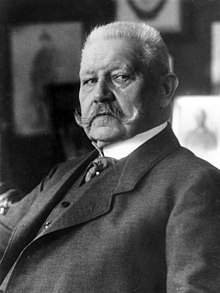Shipping from Europe with tracking number
Paul von Hindenburg
Paul Ludwig Hans Anton von Beneckendorff und von Hindenburg (![]() listen), typically known simply as Paul von Hindenburg (German: [ˈpaʊl fɔn ˈhɪndn̩bʊɐ̯k] (
listen), typically known simply as Paul von Hindenburg (German: [ˈpaʊl fɔn ˈhɪndn̩bʊɐ̯k] (![]() listen); 2 October 1847 – 2 August 1934), was a German general and statesman who led the Imperial German Army during World War I and later became President of Germany from 1925 until his death in 1934. During his presidency, he played a key role in the Nazi Machtergreifung in January 1933 when, under pressure from advisers, he appointed Adolf Hitler as Chancellor of Germany.
listen); 2 October 1847 – 2 August 1934), was a German general and statesman who led the Imperial German Army during World War I and later became President of Germany from 1925 until his death in 1934. During his presidency, he played a key role in the Nazi Machtergreifung in January 1933 when, under pressure from advisers, he appointed Adolf Hitler as Chancellor of Germany.
Paul von Hindenburg was born on 2 October 1847 to a family of minor Prussian nobility in Posen. Upon completing his education as a cadet, he enlisted in the Third Regiment of Foot Guards as a second lieutenant. Hindenburg thereafter saw combat during the Austro-Prussian and Franco-Prussian wars. In 1873, he was admitted to the prestigious Kriegsakademie in Berlin where he studied for 3 years before being appointed to the Army's General Staff Corps. Later in 1885, he was promoted to the rank of major and became a member of the Great General Staff. Following a five-year teaching stint at the Kriegsakademie, Hindenburg steadily rose through the army's ranks to become a lieutenant-general by 1900. Around the time of his promotion to General of the Infantry in 1905, Count Alfred von Schlieffen recommended that he succeed him as Chief of the Great General Staff but the post ultimately went to Helmuth von Moltke in January 1906. Subsequently in 1911, Hindenburg announced his retirement from the military.
Following the outbreak of World War I in July 1914, he was recalled to military service and quickly achieved fame on the Eastern Front as the victor of Tannenberg. Subsequently, he oversaw a crushing series of victories against the Russians that made him a national hero and the center of a massive personality cult. By 1916, Hindenburg’s popularity had risen to the point that he replaced General Erich von Falkenhayn as Chief of the Great General Staff.[1] As a result of Emperor Wilhelm II's broad delegation of authority to the German Army High Command, a de facto military dictatorship was ultimately established by Hindenburg and his deputy, General Erich Ludendorff, which dominated national policy for the rest of the war. Under their leadership, Germany defeated Russia's forces in the East and achieved advances in the West deeper than any seen since the conflict's outbreak. However, by the end of 1918, any improvements in Germany's fortunes were reversed after the German Army was decisively defeated in the Second Battle of the Marne and the Allies' Hundred Days Offensive. Upon Germany's capitulation to the Allies in the November 1918 armistice, Hindenburg relinquished his leadership of the Army High Command before retiring once again from military service in 1919.
In 1925, Hindenburg returned to public life to become the second elected President of the German Weimar Republic. Despite being personally opposed to Hitler and the Nazi Party, he was nonetheless a major figure in the political instability that resulted in Hitler's rise to power. Upon twice dissolving the Reichstag in 1932, Hindenburg ultimately agreed to appoint Hitler as Chancellor of Germany in January 1933 when the Nazis won a plurality in the November elections. In response to the Reichstag Fire allegedly committed by Marinus van der Lubbe, he approved the Reichstag Fire Decree in February 1933 which suspended various civil liberties. Later in March, he signed the Enabling Act of 1933 which gave Hitler's regime emergency powers. After Hindenburg died the following year, Hitler combined the Presidency with his office as Chancellor before proceeding to declare himself Führer und Reichskanzler des deutschen Volkes (i.e. "Leader and Reich Chancellor of the German People") and transform Germany into a totalitarian state.
